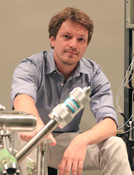2020/02/11(Tue) 10:30 -12:00 五樓第一會議室 5F, 1st Meeting Room

Title
Mott or Not? – An STM/S Investigation into the Nature of the Insulating Ground State of 1T-TaS2
Speaker
Dr. Christopher Butler (Center for Emergent Matter Science, RIKEN, Japan)Abstract
A debate about the nature of the ground state of 1T-TaS2 has persisted for decades, and in recent years has only intensified, especially after the suggestion that it might host the elusive quantum spin liquid phase [1]. 1T-TaS2 exhibits two-dimensional (2D) charge density wave (CDW) order, described as a √13×√13 superstructure of ‘Star-of-David’ (SD) clusters. Each cluster hosts an odd number of electrons (half-filling), so non-interacting band theory seems to predict metallic behavior. The experimental fact that it is an insulator, despite half-filling, points to strong electron-electron interactions – Mott physics – as the explanation. This sets the theoretical stage for a quantum spin liquid ground state. However, this line of thinking largely neglects possible inter-layer effects, and recent calculations [2,3] indicate that for a particular ‘dimerized’ pattern of inter-layer stacking, an insulating state can be realized without invoking Mott.
I will present scanning tunneling microscopy (STM) measurements showing two distinct surface terminations of the 3D charge order - the sign of a stacking pattern which indeed has two dimerized SDs per 3D unit-cell. We determine the intrinsic inter-layer stacking vectors, and also identify an extrinsic stacking vector which renders the surface metallic, emphasizing the importance of inter-layer coupling for the electronic properties. This layer dimerization, together with naïve band theory, might explain the insulating state in the bulk. However, we notice that a spectral gap can persist at surfaces where the dimerization is broken and a metallic surface should be expected, again implicating Mottness as the reason. Another clue that Mottness is key in the insulating state comes from the appearance of narrow conductance peaks at the onset of unoccupied states, with clear electron-phonon replicas corresponding to excitations of the CDW amplitude mode. These peaks may be signatures of transient ‘doublon’ excitations, characteristic excitations of a Mott insulator.
[1] P. A. Lee, Proc. Nat. Acad. Sci. 114, 6996-7000 (2017).
[2] T. Ritschel, H. Berger & J. Geck, Phys. Rev. B 98, 195134 (2018).
[3] S.-H. Lee, J. S. Goh & D. Cho, Phys. Rev. Lett. 122, 106404 (2019).
Abstract
Language
演講語言 (Language): in English